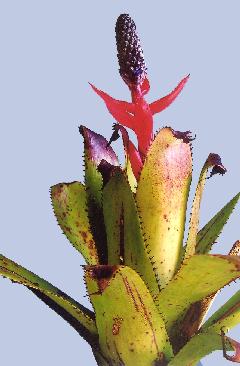
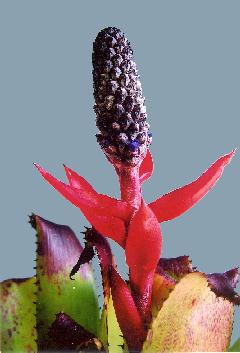
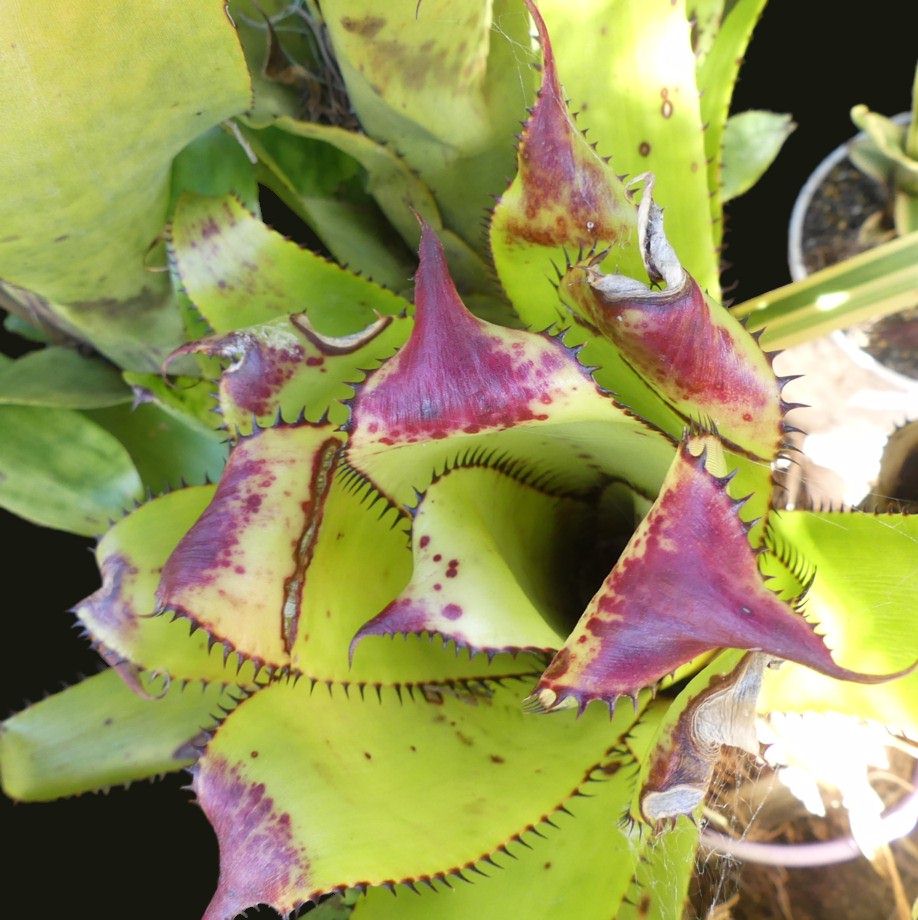
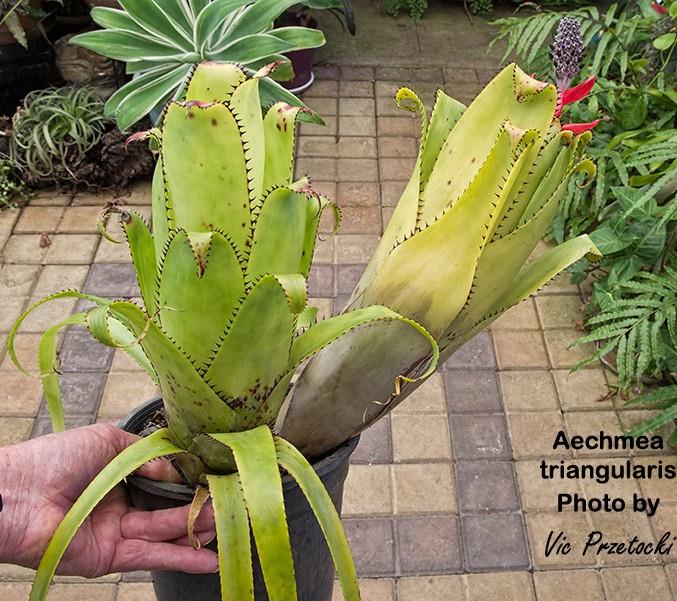
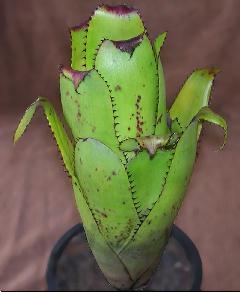
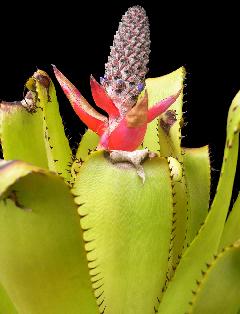
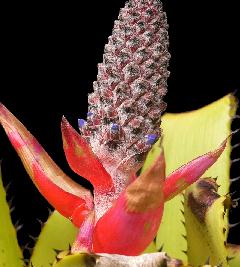
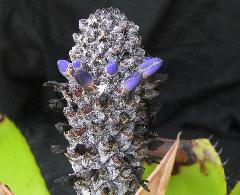
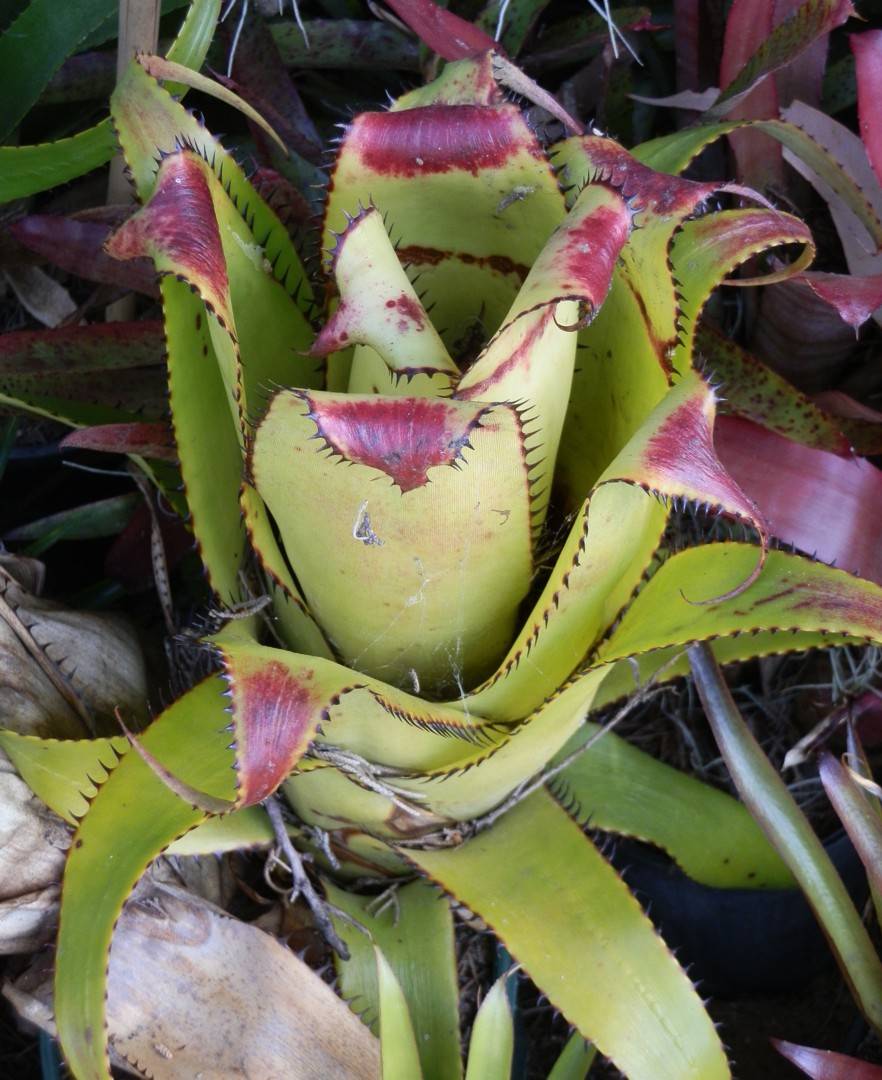
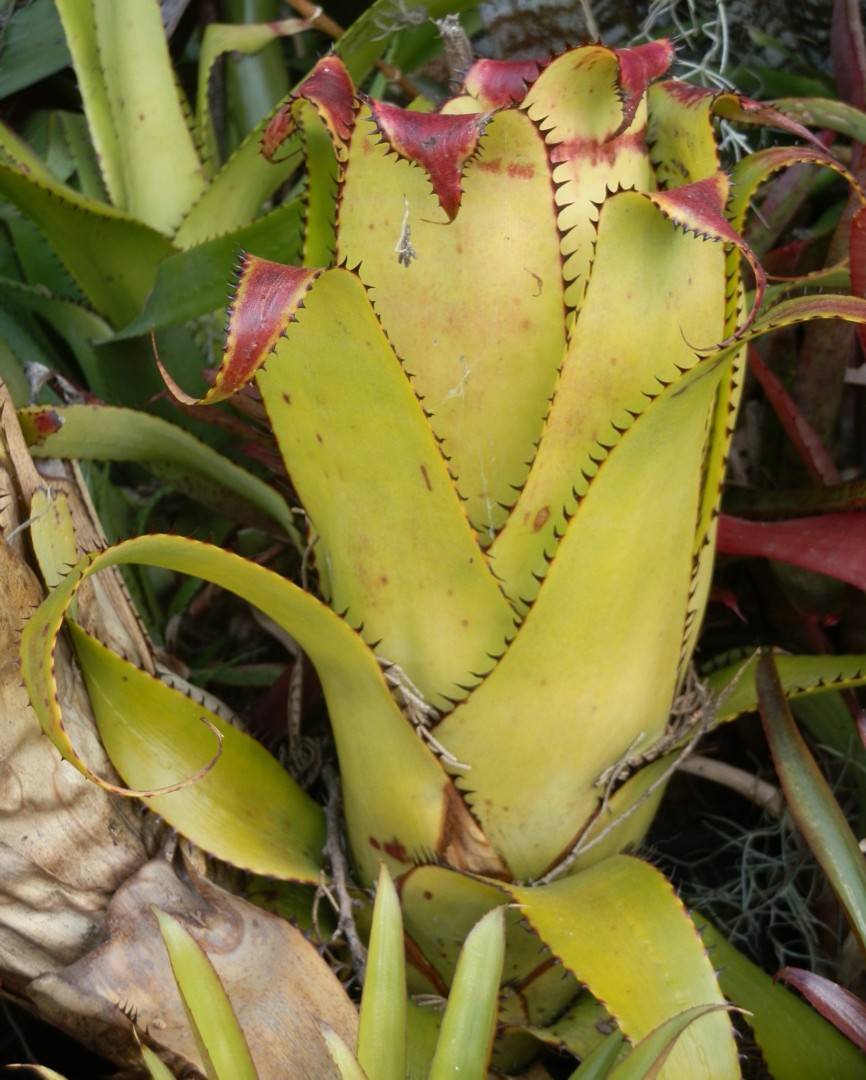
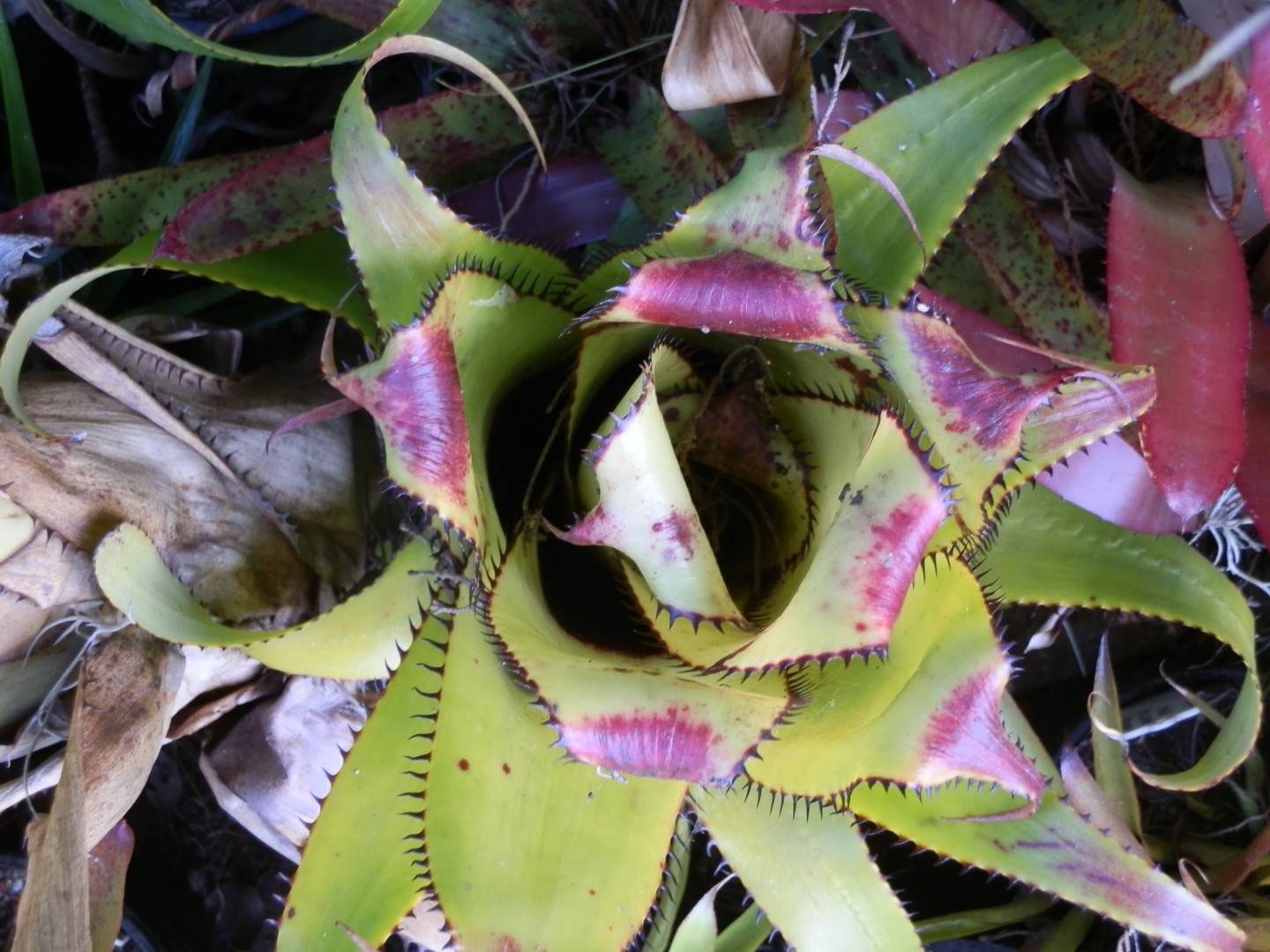
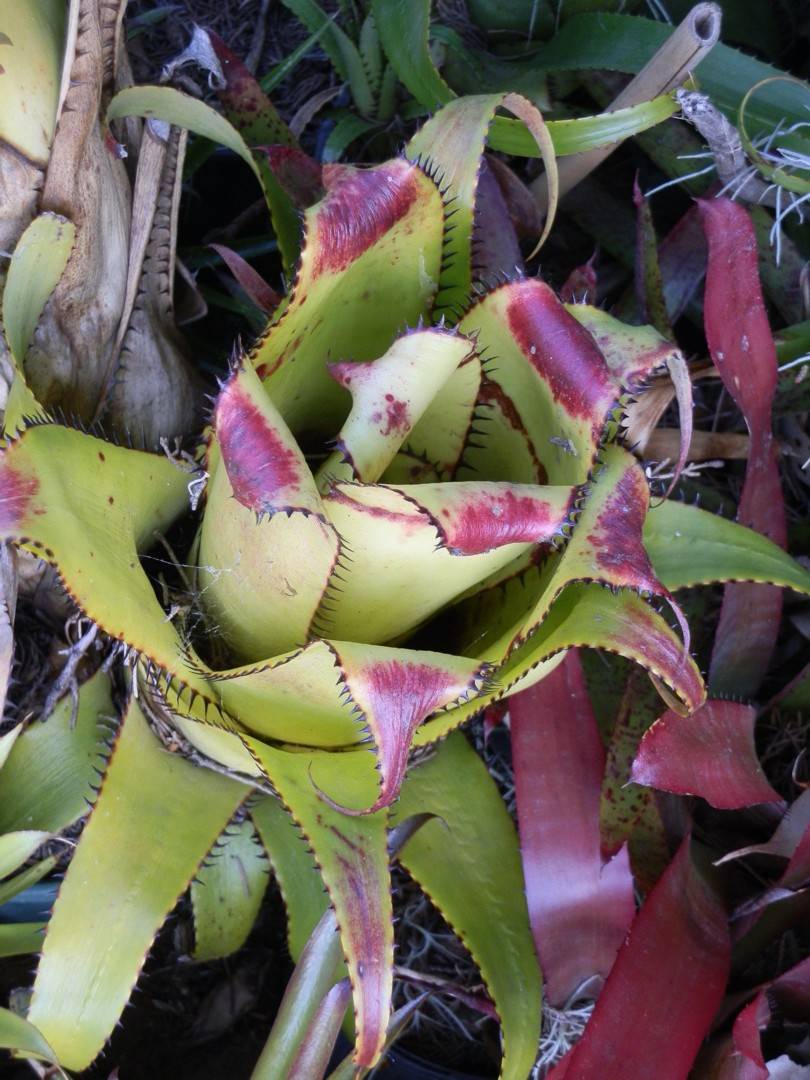
Aechmea triangularis can be easily recognized, especially among the other species of Aechmea subg. Macrochordion mainly by being the only species to have a blue corolla. Aechmea triangularis has been considered endemic in the State of Espirito Santo, where it occurs as an epiphyte in areas of Floresta Ombrofila Densa Montana, at altitudes between 650-1000 m (Faria et al. 2010; Forzza et al. 2013). However, two populations of this species were found in the Eastern Central Region of the State of Parana, this being the first record of the species in this State. A population is located in Catanduva de Fora (24° 44 ' 57 "S-50° 01 ' 26" W), municipality of Carambei, and another on the outskirts of the Cachoeira da Mariquinha (25° 02 ' 12 "S-49° 56 ' 45" W), municipality of Ponta Grossa (fig. 3). These populations are composed of epiphytic individuals in the understory of Floresta Ombrofila Mista (Forest with Araucaria), at altitudes close to 1000 m. The causes of the disjunct distribution of this species have not yet been clarified.
Faria et al. (2010) stated that Aechmea triangularis is in danger of extinction in the State of Espirito Santo, which has restricted geographical distribution and little is represented in herbarium collections. In Parana, following criteria established by the IUCN (2001, 2012), a species is critically endangered of extinction (CR: B1B2ab
iii
D), if in small, isolated populations, with extension of occurrence estimated at around 70 km² and an area of occupancy in only 24 km². In addition, both populations of Parana are threatened by antropic action, suffering probable decline, those from Catanduva de Fora (Carambei) being victim of deforestation and from Cachoerira da Mariquinha (Ponta Grossa) being subject to action of intense tourist activity without environmental damage control rules, though they are found inside the Campos Gerais National Park, still under implementation.
Aechmea triangularis L.B.Sm., Smithsonian Misc. Collect. 126: 19, 224, f. 106. 1955 by De Faria, Wendt & Brown in Bot Journ. Linn. Soc. 162: 10-18. 2010
Type: Brazil, Espirito Santo, St Teresa, 7.viii.1940 (bloomed in cultivation 22.iv.1941), Foster 829 (Holotype: GH!, Isotype: GH!).
= Macrochordion triangularis (L.B.Sm.) L.B.Sm. & W J.Kress, Phytologia 66(1): 77. 1989. H.E.Luther & E.Sieff, Selbyana 15 (1):65. 1994, pro syn.
= Aechmea kautskyana E. Pereira & L.B.Sm., Bradea 3: 46-7, 49. 1980. Type: Brazil, Espirito Santo, Conceicao do Castelo, Forno Grande, 8.viii.1979, Kautsky 643 (Holotype HB!, Isotype US! photo), syn. nov.
= Macrochordion kautskyana (E. Pereira & L.B.Sm.) L.B.Sm. & W J.Kress, Phytologia 66(1): 77. 1989, syn. nov.
HERB epiphytic, 23.5-50 cm high.
ROSETTE funnelform or wide-funnelform with 15-20 leaves.
LEAF SHEATHS 8-18 x 4.5-20 cm, orbicular to elliptic, adaxial surface purple, abaxial surface green.
LEAF BLADES 10-72 x 1.5-6 cm, linear or linear tri¬angular, concolorous green, sometimes purple spotted, apex caudate, recurved, margins serrate or sparsely serrate; spines black, 3-7 mm long.
INFLORESCENCE with spike 3-6 x 2-3 cm; peduncle vinaceous, 20-41 cm long, white floccose; peduncle bracts sub¬dense and divergent, margins denticulate toward the apex, dark pink or red, 4-7.5 x 1.3-3 cm, apex acute or acuminate.
FLOWERS 1.6-2 cm long.
FLORAL BRACTS 8-11 x 11-13 mm, depressed ovate, shorter than the sepals, coriaceous, red to the middle and castaneous toward the apex, white floccose, apex truncate, apiculate.
SEPALS 6-8 x 4 mm, symmetric or slightly asymmetric, connate to the middle, vinaceous or castaneous with red margins, covered with white appressed scales, apex emarginate, minutely apiculate.
PETALS 12-16 x 4 mm, spatulate, dark blue with white base, apex emarginate, erect; fimbriate ligulae about halfway along the lateral folds.
STAMENS with filaments c. 1 cm long; anthers 4-5 mm long. STIGMA c. 1 mm long. OVARY c. 4 mm long, bearing a short epigynous tube, ovules c. 0.5 mm long.
FRUITS and seeds not observed.
Distribution and habitat:
Aechmea triangularis is endemic to Espirito Santo state (Fig. 4D) and is poorly represented in herbarium collections. It grows at 650-1000 m altitude, in dense ombrophile forest.
Conservation status: Endangered (IUCN, 2001).
Notes: Aechmea triangularis is the most distinctive taxon in Aechmea subgenus Macrochordion and can be easily recognized by both vegetative (e.g. leaves with caudate and recurvate apices) and reproductive (e.g. dark blue corolla) characters. As noted by Pereira (1980) on the original description, A. kautskyana also has blue petals. The author, however, stressed the presence of dimorphic leaf blades as a relevant character in considering A. kautskyana distinct from A. triangularis. Differences between inner and outer leaf blades were also observed in some herbarium and living specimens of A. triangularis. This characteristic, however, is not present in young plants as occurs in true dimorphic leaves. In mature plants of A. triangularis, the inner leaves of the rosette are narrower and suddenly become broader, and the same seems to occur in A. kautskyana. Until this study, A. kautskyana remained known only from the type specimen. The close morphological similarity indicated in the phenetic analyses (Figs 1, 2) supports the synonymy proposed for these species.
Aechmea triangularis L. B. Smith, Smithson. Misc. Collect. 126: 19, 224, fig. !06. 1955.
A Ae. brorneliifolia (Rudge) Baker, cui affinis, laminis foliorum caudato-acuminatis, bracteis florigeris nullo modo retusis, petalis purpureis differt.
Aechmea kautskyana Pereira & L B Smith, Bradea 3: 46-7, 49. 1980 see Binomials 6, 1998 p3
Desc from S&D
Plant flowering to 37 cm high.
Leaves to 5 dm long, covered with a membrane of pale appressed scales;
Sheaths elliptic, 18 cm long, 9 cm wide, near the apex densely serrate with dark spreading spines 5 mm long, green with small red spots, elsewhere entire and dark brown;
Blades narrowly triangular, caudate-acuminate, 4 cm wide at base, laxly serrate with spreading or antrorse teeth.
Scape erect, 3 mm in diameter, white flocculose;
Scape-bracts broadly elliptic, thin, rose-like, inconspicuously lepidote with white appressed scales, the lower ones much shorter than the internodes, caudate, serrate near the apex, the upper ones much longer than the internodes, divergent, serrate throughout.
Inflorescence simple, strobilate, cylindric, 6 cm long, 2 cm in diameter exclusive of the petals, densely lepidote with white subappressed scales.
Floral bracts orbicular, apiculate, 8 mm long, exceeding the ovary, coriaceous, bicarinate.
Sepals 6 mm long, connate for 2 mm, the free lobes asymmetric, subquadrate, retuse, unarmed;
Petals 12 mm long, lavender to purple turning black the second day, bearing 2 fimbriate scales high on the claw, blade broadly elliptic, obtuse;
Epigynous tube almost none; placentae apical; ovules caudate.
Type. Foster 829 (holotype, GH), Santa Teresa, Espirito Santo, Brazil, 2 Aug 1940, bloomed in cultivation 22 Apr 1941.
Distribution. Known from the type collection only.
Aechmea kautskyana Pereira & L B Smith, Bradea 3: 46-7, 49. 1980 treated as a synonym of A. triangularis in Binomials 6, 1998 p3
Florifera usque 50cm alta. Folia circa 15, rosulata, ligulata, utriculum tubulosum formantia; interiora, vagina lato eliptica, 12-20 cm lata, paulo maiore quam limbus est vel aequante, interius atro-purpurea et albo-lepidota, exterius viridi et inconspicue lepidota; limbo sublineari, 8-15cm longo, 5-6cm lato, utrinque inconspicue lepidoto, apice rotundato, recurvato et longe mucronato subpungente, margine laxe spinis atro-purpureis, usque 4mm longi, armata. Folia exteriora vagina ovata, 8cm longa, 6cm lata, minora quam limbus est; limbo anguste triangulari, 20cm longo, 2cm maxime latitudine, sensin in apicem acuminatum exeunti, margine spinis usque 7mm longi, inter se 5mm distantibus armata. Scapus erectus l0mm diamet. (in sicco 5mm), 38cm longus, atropurpureus et dense albo-lepidotus, internodiis 3-4cm longis; bracteis scapalibus inferioribus totaliter amplectantibus, roseis, albo lepidotis, sed interius glabris, fere rectangularibus, spice rotundato et curvato-mucronato, margem integerrima, 4cm longis, 3cm latus quam internodiis paulo minoribus vel paulo longioribus; bracteis scapalibus prope inflorescentiam valde aggregatis, atro-purpureis, patentibus, nullo modo amplectentibus, lanciformibus, margine serrata, 6cm longis, 2cm maxime latitudine. Inflorescentia erecta, simplissima, strobiliforme, ellipsoidea, 7cm longa, 4cm diamet. (in sicco 5cm longis, 3cm diamet.), totaliter excepto corollae atro-purpurea et dense albo-lepidota; bracteis florigeris suborbicularibus, concavis, apice truncato-apiculato, dorso tricarinato et gibboso, 8mm diamet., ovarium aequantibus et involventibus sed haud in totum. Flores 20mm longis, sessilis; sepalis assymetricis, ovalibus, 8mm longis, 4mm alte connatis, spice obtuse, nulo modo apiculato neque mucronato; petalis atro-azureis demum nigricenti, lineari-spathulatis, 15mm longis, spice rotundato, emarginato et emarginato et minutissime denticulato, supra basin ligulis binis, fimbriatis auctis; anthereis 5mm longis, linearibus, basi obtuse sagittata, apice apiculato; ovario 4mm longo; tubo epigineo 2mm longo; placentis apice loculis affixis; ovulis paucis, longe caudatis.
TYPUS: Espirito Santo: Munic. Conceicao do Castelo, Forno Grande, 1000 msm leg. cl. Roberto Kautsky Nr. 643, 08.Aug.1979 - HOLOTYPUS H B-70658. ISO-US.
Pelo habito esta nova especie aproxima-se de A. bromelifolia (Rudge)Baker, da qual se aparta logo a primeira vista pela cor das flores purpureas. Nos detalhes das flores aproxima-se mais de A. triangularis L. B. Smith da qual se diferencia a primeira vista na parte vegetativa pelas folhas dimorfas.
Plant flowering up to 50cm high.
Leaves about 15, rosulate, ligulate, forming a tubular utriculum;
Sheath interior wide elliptic, 12-20 cm wide, a little larger than or equalling the blade, inside dark purple and white lepidote, outside green and inconspicuously lepidote;
Blades sublinear, 8-15cm long, 5-6cm wide, both sides inconspicuously lepidote, tip rounded, recurved and with a long subpungent mucron, edges laxly dark purple spined, up to 4mm long.
Sheath exterior ovate, 8cm long, 6cm wide, smaller than the blade;
Blades narrow triangular, 20cm long, 2cm maximum width, gradually terminating to an acuminate tip, edges with spines up to 7mm long, 5mm apart.
Scape erect l0mm diam. (when dry 5mm), 38cm long, dark purple and dense white lepidote, internodes 3-4cm long;
Scape bracts lower ones totally enclosing the scape, pink, white lepidote, but inside glabrous, almost rectangular, tip rounded with a curved mucron, edges entire, 4cm long, 3cm wide, a little shorter or a little longer than the internodes, those near the inflorescence strongly clustered, dark purple, spreading, not at all enclosing the scape, lanciform, edges serrate 6cm long, 2cm maximum width.
Inflorescence erect, simple, strobiliform, ellipsoid, 7cm long, 4cm diam. (when dry 5cm long, 3cm diam.), except for the corolla totally dark purple and dense white lepidote;
Floral bracts suborbicular, concave, tip blunt apiculate, on the back 3 keeled and gibbose, 8mm diam., equalling the ovary but not totally enclosing it.
Flowers 20mm long, sessile;
Sepals asymmetric, ovate, 8mm long, connate for 4mm, tip blunt, not at all apiculate nor mucronate;
Petals dark blue later blackish, linear spathulate, 15mm long, tip rounded, emarginate and and very small denticulate, above the base 2 fimbriate ligules;
Anthers 5mm long, linear, base blunt sagittate, tip apiculate;
Ovary 4mm long; epigynous tube 2mm long; placenta joined to the top of the locules; ovules few, long caudate.
In its habit this new species is closest to A. bromelifolia from which it is readily distinguished by its purplish flowers. In the flower details it is closest to A. triangularis L. B. Smith from which it differs immediately in the dimorphic leaves.